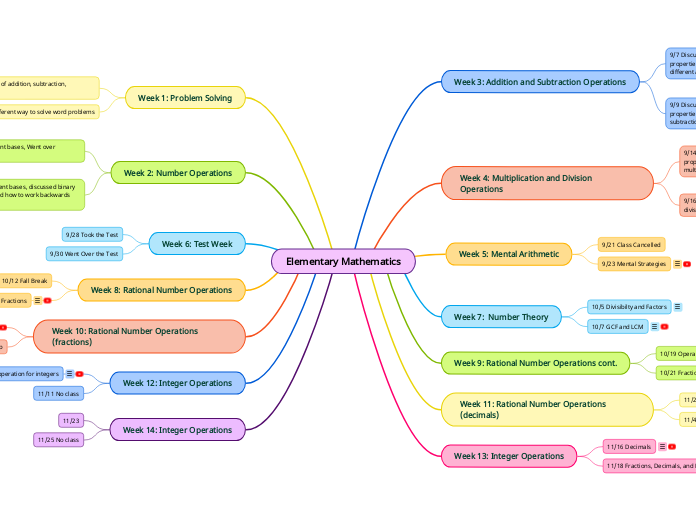
9/7 Discussed communicative, associative, and distributive properties in relation to addition, discussed partial sums, the different algorithms,
Addition Defined
addition=join; the numbers you are adding=addents; the answer you get=sumex. : 3+4=7; 3 and 4 are addents, 7 is the sum
Properties
identity property: any number plus zero equals itself; ex. (7+0=7)communicative property: the order of numbers doesn't matter in addition; ex. (3+4=4+3)associative property: the grouping in addition doesn't matter; ex. ((3+5)+4=3+(5+4))
Video on properties of addition
https://www.youtube.com/watch?v=GtyUzH7FWN0
9/9 Discussed communicative, associative, and distributive properties in relation to subtraction, integer subtraction, subtraction algorithms
Types of Subtraction Algorithms
american standardeuropean standardreverse indianleft to rightexpanded notationinteger subtraction
9/14 discussed skip counting, repeated addition, went over the properties of multiplication, went over algorithms of multiplication, place values, expanded notation, lattice
Properties of Multiplication
communicative property: the order of numbers don't matter; ex. (8x3=3x8)identity property: any number multiplied by 1 is itself; ex. (8x1=8)zero property: any number multiplied by zero is zero; ex. (8x0=0)associative property: grouping doesn't matter when multiplying; ex. ((8x3)x7=8x(3x7))distributive property: you can break up the numbers being multiplied; ex. (3x7=(3x5)+(3x2))
Video on standard algorithm
https://www.youtube.com/watch?v=ItXOu8o5Lbs
9/16 discussed how division is repeated subtraction, long division, alternate algorithms to divide
Division Vocab
Divisor; what you divide byQuotient; the answer you getDividend; number you are dividingRemainder; what is left over after you divideex: (24/5=4remainder4), 24 is the dividend, 4 is the quotient, 4 is remainder, 5 is the divisor
Video on Alternate Division
https://www.youtube.com/watch?v=PjKVDGwcMdo
9/21 Class Cancelled
9/23 Mental Strategies
Addition: left to right, (front end addition)compensation (find a number close by that's easier to add)compatible numbers (add segments of a problem together at a time)breaking up and bridging (break up a large number into 2 and add them separately
10/5 Divisibilty and Factors
a is divisible by b, if there is a number c that meets the requirement; b x c = a; ex. 10 is divisible by 5, 5x2=10terminology10 is divisible by 5 or 5 divides 105 is a divisor of 105 is a factor of 1010 is a multiple of 5rulesif it ends with these digits it can be divided by that numberby 2: 0,2,4,6,8by 5: 0,5by 10: 0sum of digitsby 3 ex. 543, 5+4+3=12; since 12 can be divided by 3, so can 543
10/7 GCF and LCM
GCF: Greatest Common FactorLCM: Least Common Multipleexample: 24 and 36 -> GCF: 12, LCM: 72List Method: Multiples:24: 24, 48, 72, 9636: 36, 72 Factors24: 1,2,3,4,6,8,12,2436:1,2,3,4,6,9,12,18,36Prime Factorization Method:Prime factor tree to find prime factors of a number, (refer to video)HW #5
10/19 Operations of fractions
Simplify fractions by dividing top and bottom by the GCFMultiplying Fractions((Multiplication makes the products smaller with fractions.))when multiplying factions you can just multiply across without making the denominators equal ex. 2/3 x 1/4 = 2/12; 3/4 x 1/3= 3/12Dividing Fractions6/3 "how many times does 3 go into 6" 2 times so 6/3=21/ 1/2 "how many times does 1/2 go into 1" 2 times so 1/ 1/2=2
10/21 Fractions Practice
Practice Problems:There was 3/4 of a pie in the refrigerator. John ate 2/3 of the left over pie. How much pie did he eat?Answer: (3/4) x (2/3) = 6/12 or 1/23/4 of the class are girls. 2/3 of the girls have black hair. What fraction of girls with dark hair? Answer: (3/4) x (2/3) = 6/12 or 1/2
11/2 Test #2
11/4 Go over test #2
11/16 Decimals
Go over places in decimals ex. ones, tenths, hundredths converting decimals to fractions and vice versa ex. 3/10 to .3go over adding decimals
11/18 Fractions, Decimals, and Percentages
percent= per 100 (out of 100)10% off $200; for every $100 you get $10; =$180round up repeating decimals
8/24 Discussed the meaning of addition, subtraction, multiplication, and division
8/26 Discussed different way to solve word problems
8/31 Introduced working in different bases, Went over expanded notation
Notes on Bases
discussed how a number in a certain base only can contain digits that are less than the baseex. a number in base 5 can only contain digits 0,1,2,3,4ex. of a base problem (43base5=23base10)
Video on working with bases
https://www.youtube.com/watch?v=FFDMzbrEXaE
9/2 Continued talking about different bases, discussed binary system (working in base 2), learned how to work backwards from different bases to base 10,
Notes on working Backwards
working in base 2 is called the binary systemex. of binary problem (11011base2=27base10)practiced going from a different base and going back to base 10ex. of backwards problem (17=32base5)discussed how to check work by going from your answer back to the original base
Video on working backwards with bases
https://www.youtube.com/watch?v=-PI7ZX3UiXA
9/28 Took the Test
9/30 Went Over the Test
10/12 Fall Break
10/14 Fractions
Went over HW #5FractionsFraction: symbol that represents part of a wholefractions represent ratiosModels; surface area, sets of things, length, number line
10/26 Practice with Word Problems
Did Practice with word problems and went over HW #6
10/28 Test Prep
11/9 Relearn basic operation for integers
adding positive and negative numbers ex. 3+(-2)= 1subtracting positive and negative numbers ex. (-3)-(2)= -5multiplying positive and negative numbersdividing positive and negative numbers
11/11 No class
11/23
11/25 No class